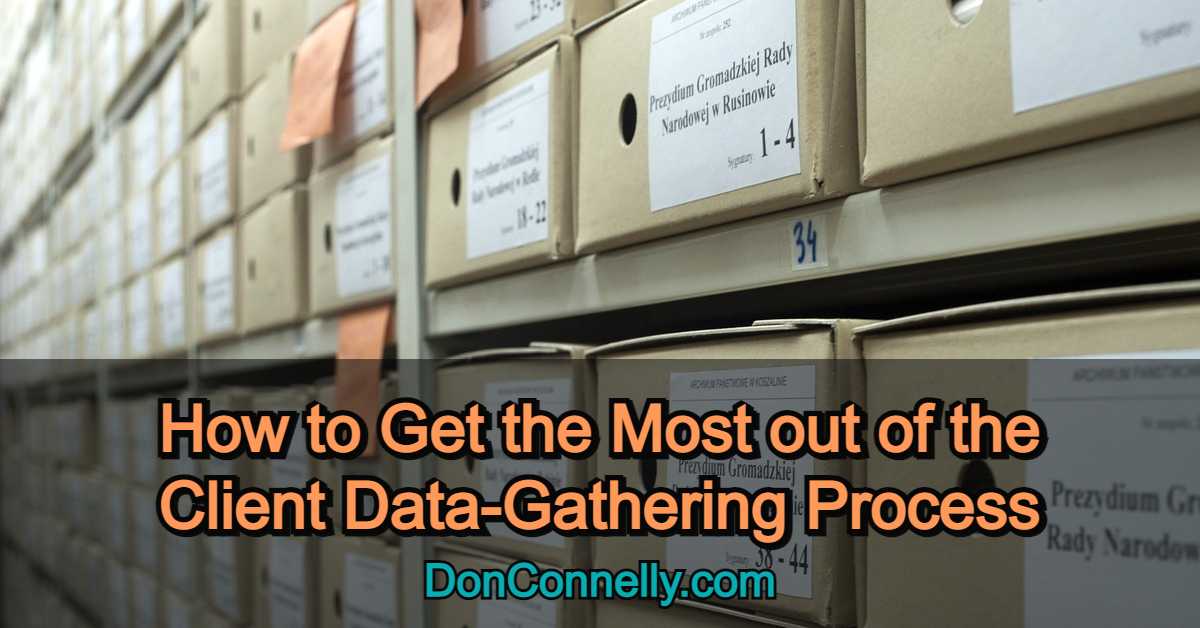How to Get the Most out of the Client Data-Gathering Process
 Next to the initial meeting with a prospect, data gathering is the most critical step in the relationship-building process. Of course, it’s also the most vital step in the financial planning process, without which advisors can’t analyze a client’s situation, make proper recommendations, and implement them. That’s well understood by most advisors. Less understood is the critical role the data-gathering step plays in increasing client engagement, building trust, and solidifying the advisor-client relationship.
Next to the initial meeting with a prospect, data gathering is the most critical step in the relationship-building process. Of course, it’s also the most vital step in the financial planning process, without which advisors can’t analyze a client’s situation, make proper recommendations, and implement them. That’s well understood by most advisors. Less understood is the critical role the data-gathering step plays in increasing client engagement, building trust, and solidifying the advisor-client relationship.
Why data gathering is so crucial
Data gathering is the first opportunity advisors have to demonstrate their competence, empathy, and overall value to new clients. If it goes badly, you may not get what you need to fulfill your role as an advisor, or the new client may second guess why they chose you. It is critical that this step must go well.
Why it goes badly for many Advisors
The challenge for advisors is that most people are wary of providing financial data. That’s not entirely because they don’t trust the advisor (hopefully, you effectively dealt with the trust issue in your earlier meetings), but rather because they are afraid of the process. Most people are not very well organized financially, and many have never really delved deeply into their financial goals.
The advisor’s challenge is making wary or hesitant new clients feel like they are squarely on board while expertly guiding them through a critical, albeit uncomfortable, process. Your job is to make them feel comfortable and like they are a genuine client. If the process is unorganized and drags on because of it, they will lose their trust in you or the process.
The other challenge is data gathering must be a thorough process. There can be no shortcuts. But if it drags on too long, clients can become squeamish or even bored with the process. That’s why you should consider breaking the data-gathering process into three parts, scheduled over three sessions:
- Getting Organized
- Goal Setting
- Data Collection
This blog post will cover the Getting Organized step, followed by separate posts on goal setting and effective data collection, which are equally critical to the data-gathering process.
The Getting Organized step
I ascribe to the Getting Organized step outlined by Michael Kitces of the XYZ Planning Network. This is a critical step because, as any experienced advisor will tell you, most new clients are not very organized, which can throw the process into disarray leading to a loss of confidence in the advisor.
Fundamental to data gathering is getting access to important financial documents such as wills, trusts, insurance policies, investment statements, retirement accounts, and loan documents, many of which are stashed in various boxes and filing cabinets or stored haphazardly online. Many times, clients aren’t certain exactly where to find them.
As a result, clients show up missing key documents or are unsure how to find their accounts online, thus dragging out the process and making them feel guilty or embarrassed at how disorganized they are.
Make Getting Organized an invaluable service
Instead of asking clients to get organized, which can be daunting, you offer your services as their advisor to help them get organized—as part of the process. Tell them to find and bring all financial documents, regardless of whether they deem them important. You can have them roll in their entire filing cabinet if they want. And let them know if they are unable to locate all their online accounts or data because that’s part of your service.
After you or your staff help the client go through all documents, prioritize, and file them, even offering to shred unimportant or outdated documents and make digital copies to store online, your new client leaves with a well-organized file box (which you provide) with clearly marked file separators. They will also know how to access all their online accounts and data because you or your staff showed them. If you have the technology, you can even help them consolidate their accounts on a single client portal provided by your firm.
From that point forward, the data-gathering process feels less like homework and alleviates the stress many clients feel having to finally organize their financial life. More importantly, new clients leave the session with a feeling of accomplishment and more confidence in the process.
Incorporating this step as part of your data-gathering process virtually guarantees the rest of the process will be smooth sailing. More crucially, you have performed an invaluable service that your clients likely never have experienced—a true differentiator, reinforcing why they chose you.
Setting your data gathering process up for success
The next step in the data-gathering process is goal setting, which, done right, will close any remaining trust gaps and position you as a financial savior. Then comes the actual data gathering, which, when conducted effectively, will provide you with deeper insights into your clients’ concerns and motivations for taking action on your recommendations.
Depending on your clients’ availability, you can schedule the data collection step in the same meeting as goal setting or schedule it as a separate session.
In the next posts, we will cover proven methods for effective Goal Setting and Data Collection in depth.
Watch this 3-minute video to learn how our 24-step training program can help you hone your soft skills and become brilliant at the basics to take your business to the next level.
See program details and enroll today!
Available as a self-paced program (always open) or as a 12-week coaching program (open only a couple of times a year), this training will change the way you view your practice and will give you an enormous advantage over your competition. Select your format and enroll now!



